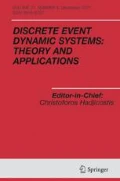Abstract
A hybrid timer system with different timer rates and idling timer feature operating in dense time is modeled as an event-driven nondeterministic automaton and it is shown that the system is weak bisimulation equivalent to a finite state nondeterministic automaton. Our original model is an event driven infinite state automaton as in Dill (1989) and an explicit representation for the bisimulation equivalent finite state automaton whose state set consists of an index set of active timers andn pairs of bounded nonnegative integers or the symbol +∞ is derived wheren is the number of clocks. The reduced model is simpler than Dill's difference bound matrix model—and similar to the model used in Alur et al. (1990)—for the finite system automaton since all difference inequalities are represented by a single order vector of integers.
Similar content being viewed by others
References
Alur, R., Courcoubetis, D., Dill, D., Halbwachs, N., and Wong-Toi, H. unpublished. An implementation of three algorithms for timing verification based on automata emptiness.
Alur, R., Courcoubetis, C., and Dill, D. 1990. Model-checking for real time systems.Proc. 5th IEEE Symp. Logic in Computer Sciences, pp. 414–425.
Alur, R., Courcoubetis, C., Halbwachs, N., Dill, D., and Wong-Toi, H. 1992. Minimization of timed transition systems (extended abstract).Proc. CONCUR '92, pp. 340–354. InLecture Notes in Computer Science, vol. 630, Springer-Verlag.
Alur, R., and Dill, D. 1991.Automata for Modeling Real-Time Systems. pp. 322–335. Lecture Notes in Computer Science, vol. 443, Springer-Verlag.
Alur, R., and Henzinger, T. A. 1989. A really temporal logic.Proc. 30th Symp. Foundations of Computer Science, pp. 164–169.
Courcoubetis, C., Dill, D., and Tzounakis, P. Forthcoming. Adding dense time properties to finite-state machines: The tool cospan.
Courcoubetis, C., Vardi, M., Wolper, P., and Yannakakis, M. 1991.Memory Efficient Algorithms for the Verification of Temporal Properties. DIMACS Series in Discrete Mathematics and Theoretical Computer Science, vol. 3. Providence, RI, American Mathematical Society, pp. 207–218.
Courcoubetis, C. and Yannakakis, M. Forthcoming. Minimum and maximum delay in real-time systems.J. Formal Methods.
Dill, D. 1989. Timing assumptions and verification of finite-state concurrent systems. InAutomatic Verification for Finite State Systems, pp. 197–211. Lecture Notes on Computer Science, vol. 407. Springer-Verlag.
Haghverdi, E., and Inan, K. 1992. Verification by consecutive projections.FORTE 92 Proceedings. IFIP.
Henzinger, T., Nicollin, X., Sifakis, J., and Yovine, S. 1992. Symbolic model-checking for real-time systems.Proc. 7th IEEE Symp. Logic in Computer Sciences, pp. 394–406.
Hoare, C. A. R. 1985.Communicating Sequential Processes. Herts, England: Prentice-Hall.
Holzman, G. 1988. An improved protocol reachability analysis technique.Software Practice and Experience February, pp. 137–161.
Lynch, N. and Attiya, H. 1990. Using mappings to prove timing properties.Proc 9th ACM Symp. Principles of Distributed Computing, pp. 265–280.
Lewis, H. 1990. A logic of concrete time intervals.Proc. 5th IEEE Symp. Logic in Computer Sciences, pp. 380–389.
Milner, R. 1989.Communication and Concurrency. New York: Springer.
McManis, J., and Varaiya, P. 1993. Modeling real-time systems using rate automata. Presentation notes for the IMA workshop on DES, University of Minnesota.
Author information
Authors and Affiliations
Rights and permissions
About this article
Cite this article
Inan, K. On a class of timer hybrid systems reducible to finite state automata. Discrete Event Dyn Syst 5, 83–96 (1995). https://doi.org/10.1007/BF01438608
Received:
Revised:
Issue Date:
DOI: https://doi.org/10.1007/BF01438608




